by Jon LeSage, editor and publisher, Green Auto Market
Here’s my take on the 10 most significant and interesting occurrences during the past week…….
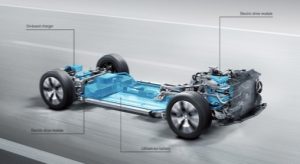 Daimler green powertrain plan: Daimler will be spending $8 billion, half its R&D budget, on green powertrains over the next two years. Daimler says that all its vehicles will be “electrified” by 2020, and a next-generation electric car platform will be coming out at production level by the end of the decade. The green powertrains will include a mix of technologies including electric, fuel-cell vehicles, and BlueTec diesels. During a tech briefing yesterday at its headquarters in Stuttgart, Germany, Mercedes-Benz announced that its upcoming GLC F-Cell hydrogen fuel-cell SUV will also include a battery pack that plugs in to recharge. It will be the first production vehicle to combine these two powertrains. Mercedes also gave details about it next-gen electric car platform. This “multi-model vehicle architecture” will be previewed as a concept vehicle at the Paris Auto Show in late September. It’s not scheduled to roll out as a production vehicle until later in the decade. It may come out first as an SUV similar to the GLC, and there’s also talk it could be a sporty sedan.
Daimler green powertrain plan: Daimler will be spending $8 billion, half its R&D budget, on green powertrains over the next two years. Daimler says that all its vehicles will be “electrified” by 2020, and a next-generation electric car platform will be coming out at production level by the end of the decade. The green powertrains will include a mix of technologies including electric, fuel-cell vehicles, and BlueTec diesels. During a tech briefing yesterday at its headquarters in Stuttgart, Germany, Mercedes-Benz announced that its upcoming GLC F-Cell hydrogen fuel-cell SUV will also include a battery pack that plugs in to recharge. It will be the first production vehicle to combine these two powertrains. Mercedes also gave details about it next-gen electric car platform. This “multi-model vehicle architecture” will be previewed as a concept vehicle at the Paris Auto Show in late September. It’s not scheduled to roll out as a production vehicle until later in the decade. It may come out first as an SUV similar to the GLC, and there’s also talk it could be a sporty sedan.- Lifecycle analysis study: A new study by Argonne National Laboratory provides a comprehensive lifecycle analysis, or cradle-to-grave analysis, of the cost and greenhouse gas emissions of a variety of vehicle-fuel pathways, as well as the levelized cost of driving and cost of avoided GHG emissions. The analysis spans a full portfolio of midsize light-duty vehicles, including conventional internal combustion engine vehicles (ICEVs), flexible fuel vehicles (FFVs), hybrid electric vehicles (HEVs), plug-in hybrid electric vehicles (PHEVs), battery electric vehicles (BEVs), and fuel cell electric vehicles (FCEVs). The study finds that battery electric vehicles with 90 to 210 miles of range, and hydrogen fuel cell cars, can lower GHG emissions to 50g CO2/mile, if the electricity will be from 100% renewable energy. The report concludes that most of the advanced vehicle technologies with the greatest potential are also the most costly, while conventional gasoline engine cars can go below 150 g CO2/mile.
- More EVS29 keynote speakers: Electric Vehicle Symposium (EVS29) organizers announced more keynote speakers for the plenary discussions. At the opening plenary on June 20, the Electric Drive Transportation Association (EDTA) will welcome delegates from around the world. Event co-hosts from Electric Mobility Canada (EMC) will be featured, and prominent policy and industry leaders from Canada and the U.S. will deliver keynote remarks on the future of electric drive. Including: Philippe Couillard, Premier of Québec; Denis Coderre, Mayor of Montréal; Kim Rudd, Parliamentary Secretary to Jim Carr, Minister of Natural Resources; Éric Martel, President and Chief Executive Officer, Hydro-Québec; and Reuben Sarkar, Deputy Assistant Secretary for Transportation, U.S. Department of Energy. A mobile app is available now for PC, Apple, and Android devices. Features include the ability to message other attendees, view the schedule, and more. Click here to register for the conference.
- Ferrari executive Marco Mattiacci has been appointed Faraday Future’s global chief brand and commercial officer. Mattiacci was president and CEO of Ferrari North America from 2010 to 2014, and helped launch Ferrari in China. At Faraday Future, he will oversee branding, marketing, communications, distribution, sales and user experience. He will also serve on the company’s key strategy, product, design, and human resources committees.
- Which stock to buy? Executives at Ford and General Motors are frustrated that their impressive financial results haven’t surged their share prices, says Automotive News columnist and news editor Dave Guilford. Ford has been trading in the low $13 range in the middle of its 52-week average. GM has been around $30, also mid-range over the past year. Tesla traded below $25 in the first month after it went public on June 29, 2010. Tesla closed at $229.34 on June 9. For Guilford, it’s all about the perceptions of the market and how the financial institutions work. “Despite vastly improved operations, GM and Ford look like buy-and-hold stocks, great if you want to collect dividends over the years,” he wrote. For Nick Bunkley, staff reporter – Ford at Automotive News, Tesla CEO Elon Musk has been as good as presidential candidate Donald Trump at shaking off bad publicity. “Almost every time Tesla Motors reports another quarterly loss, its stock price actually goes up, to the irritation and total bewilderment of Detroit auto executives who watch their shares stagnate amid record earnings,” Bunkley wrote.
- LAPD contract: BMW won a contract to supply the Los Angeles Police Department with 100 electric cars, beating Tesla Motors on the bid. BMW is leasing 100 of its i3 battery electric plug-in vehicles for $387 per car, per month. The LAPD plans to use these vehicles for community outreach and other police business, but not patrols or car chases. That will bring the city’s fleet up to nearly 200 electric vehicles in various departments.
- Green HQ: Toyota will be powering 25% of its electricity with a 7.7-megawatt solar array at its new North American headquarters in Plano, Texas. The automaker will have to capacity to go to 100% renewable energy in the long run. Toyota is seeking LEED platinum certification, the US Green Building Council’s highest level, at its new corporate campus. The new facility is slated to open in May 2017.
- Electric cargo trucks: BYD Motors will be providing 27 battery electric trucks to San Bernardino County’s regional government association in California. The electric trucks will serve three communities heavily impacted by truck emissions. A state grant of $9.1 million was awarded. “This project will help put the very cleanest trucks to work where they are heavily utilized, moving cargo within freight yards,” said Mary D. Nichols, chair of the California Air Resources Board. “Cleaner trucks mean cleaner air for all Californians, but especially for those who live in neighborhoods next to these freight transfer facilities.”
- Carsharing VW plug-ins: Zipcar’s London fleet will now include 50 brand-new Volkswagen Golf GTE plug-in hybrids. It’s part of a new partnership with Westminster City Council and Volkswagen UK. The new Volkswagen PHEVs can be rented for £7 ($9.93) an hour — the same rate that the gas-powered Volkswagen Golf can be rented from Zipcar in London.
- UberMan blog: My new book, Tales of UberMan: An auto journalist shares his Prius with savvy riders, now has a blog with content from the book and news developments in the field – including more details on the class-action lawsuit settlement by Uber drivers. You can also read one of the book’s chapters, “Taking drinkers off the roads and listening to their sad tales.” The chapter features a few interesting tales and digs into the social and safety issues Uber and Lyft drivers face driving drunk riders.


 If you’re a fan of science fiction author Philip K. Dick, and movies made from his writings, you’ve probably been thinking about flying cars for years. Featured in the Do Androids Dream of Electric Sheep? novel and Blade Runner film – and “The Electric Ant” and “Minority Report” short stories (along with the Steven Spielberg film Minority Report) – flying cars will be one of the mobility options we use daily, according to the author.
If you’re a fan of science fiction author Philip K. Dick, and movies made from his writings, you’ve probably been thinking about flying cars for years. Featured in the Do Androids Dream of Electric Sheep? novel and Blade Runner film – and “The Electric Ant” and “Minority Report” short stories (along with the Steven Spielberg film Minority Report) – flying cars will be one of the mobility options we use daily, according to the author.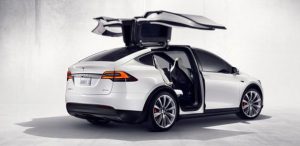 May EV and hybrid sales: The Tesla Model X has seen a huge sales increase – up a third from the previous month. Consumer Reports did feature a critical review in print and video, focused mainly on concerns with the falcon doors and too many bells and whistles versus practical features. That was released last week, so we’ll have to check on June sales to see if it’s having an impact. The Model S is seeing some decline in sales month-over-month and year-over-year. The Ford Fusion Energi is doing well in sales, and is getting closer to the Fusion Hybrid in overall sales numbers. The Ford C-Max Energi continues to soften in sales. Overall battery electric and plug-in hybrid electric vehicle sales were flat from April, and were up 5.5% over May 2015. Hybrid sales as a share of total U.S. new vehicle sales increased slightly – up to 2% of the total share after it had been hovering below the 2% mark for several months. Since it was debuted in January 2015, the Toyota RAV4 Hybrid has become a hot seller. Now at No. 2 in the rankings, it came in at No. 9 during the month of December 2015 with 1,430 units sold that month. The hybrid version was debuted a few months after Toyota halted production of the low-selling all-electric RAV4.
May EV and hybrid sales: The Tesla Model X has seen a huge sales increase – up a third from the previous month. Consumer Reports did feature a critical review in print and video, focused mainly on concerns with the falcon doors and too many bells and whistles versus practical features. That was released last week, so we’ll have to check on June sales to see if it’s having an impact. The Model S is seeing some decline in sales month-over-month and year-over-year. The Ford Fusion Energi is doing well in sales, and is getting closer to the Fusion Hybrid in overall sales numbers. The Ford C-Max Energi continues to soften in sales. Overall battery electric and plug-in hybrid electric vehicle sales were flat from April, and were up 5.5% over May 2015. Hybrid sales as a share of total U.S. new vehicle sales increased slightly – up to 2% of the total share after it had been hovering below the 2% mark for several months. Since it was debuted in January 2015, the Toyota RAV4 Hybrid has become a hot seller. Now at No. 2 in the rankings, it came in at No. 9 during the month of December 2015 with 1,430 units sold that month. The hybrid version was debuted a few months after Toyota halted production of the low-selling all-electric RAV4.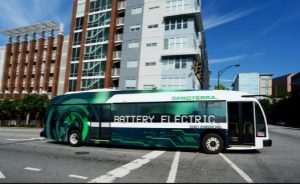 US-China electric bus competition: On Friday in Los Angeles, U.S. Secretary of Transportation Anthony Foxx and Chinese Minister of Transport Yang Chuantang signed an agreement officially announcing the US-China “Race to Zero Emissions.” One city from each of the two countries will be competing to determine which one will deploy the highest percentage of emission free buses by 2025. The race is designed to improve air quality in urban areas and prevent climate change. For each of the cities entering the competition, the minimum size of the fleet must be 200 or more buses. Two smaller transit properties can form a team and compete in the race if their combined fleet size is 200 buses or more. Potential participants can learn more at
US-China electric bus competition: On Friday in Los Angeles, U.S. Secretary of Transportation Anthony Foxx and Chinese Minister of Transport Yang Chuantang signed an agreement officially announcing the US-China “Race to Zero Emissions.” One city from each of the two countries will be competing to determine which one will deploy the highest percentage of emission free buses by 2025. The race is designed to improve air quality in urban areas and prevent climate change. For each of the cities entering the competition, the minimum size of the fleet must be 200 or more buses. Two smaller transit properties can form a team and compete in the race if their combined fleet size is 200 buses or more. Potential participants can learn more at 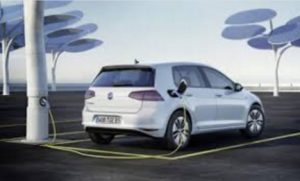 VW EV 2025 target: As Volkswagen Group emerges from its diesel emissions scandal and faces increasingly strict government mandates on reducing vehicle carbon emissions, the German automaker expects
VW EV 2025 target: As Volkswagen Group emerges from its diesel emissions scandal and faces increasingly strict government mandates on reducing vehicle carbon emissions, the German automaker expects  Have you ever taken an Uber ride to the airport, work, concert, or out on a date? Not only have I taken a few Uber rides, I’ve put in quite a few hours and miles on the road as an Uber driver. I’ve also written a non-fiction book about it that was published Friday on Kindle,
Have you ever taken an Uber ride to the airport, work, concert, or out on a date? Not only have I taken a few Uber rides, I’ve put in quite a few hours and miles on the road as an Uber driver. I’ve also written a non-fiction book about it that was published Friday on Kindle, 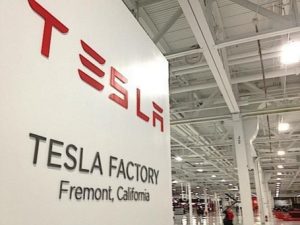 Tesla taking heat over immigrant worker and supplier relations: Tesla Motors has been facing challenges lately on the vehicle manufacturing front; one of these controversies comes from
Tesla taking heat over immigrant worker and supplier relations: Tesla Motors has been facing challenges lately on the vehicle manufacturing front; one of these controversies comes from 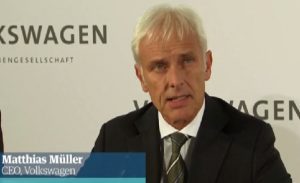 Volkswagen CEO Matthias Mueller will be speaking to the company’s senior management in mid-June on how VW will emerge from the diesel emissions scandal more as a
Volkswagen CEO Matthias Mueller will be speaking to the company’s senior management in mid-June on how VW will emerge from the diesel emissions scandal more as a 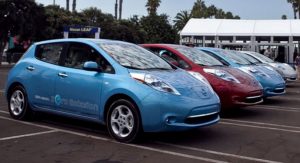 Colorado EV incentive: Colorado, which has long been an electric vehicle friendly state, is switching over from a formula-based tax credit to
Colorado EV incentive: Colorado, which has long been an electric vehicle friendly state, is switching over from a formula-based tax credit to  It’s been a big year for breaking news on the clean mobility front, with General Motors investing a half billion in Lyft and Apple announcing last week that it’s investing $1 billion in Didi Chuxing Technology. Apple appears to be just as serious about investing in mobility services as is Silicon Valley neighbor Google and its self-driving car project.
It’s been a big year for breaking news on the clean mobility front, with General Motors investing a half billion in Lyft and Apple announcing last week that it’s investing $1 billion in Didi Chuxing Technology. Apple appears to be just as serious about investing in mobility services as is Silicon Valley neighbor Google and its self-driving car project.